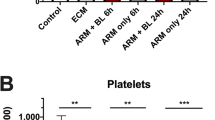Abstract
Cerebral malaria (CM) is still responsible for unacceptable death rate, while new antimalarial drugs were recently developed. CM pathophysiology shares essential biological features with cerebral ischemia. Because erythropoietin (Epo) was demonstrated to reduce mortality rate during experimental cerebral ischemia (1), in the early 2000, we wondered whether Epo could help to reduce the burden of CM. There is now evidence that Epo high doses could prevent early mortality during cerebral malaria. This evidence was obtained first using mice model of cerebral malaria, and later confirmed by prospective clinical trial in endemic area. High doses of Epo are needed to cross the blood–brain barrier (see Note 1) and to favor the cytoprotective versus hematopoietic effect of this pleiotropic cytokine (see Note 2).
Access this chapter
Tax calculation will be finalised at checkout
Purchases are for personal use only
Similar content being viewed by others
References
Sakanaka M, Wen TC, Matsuda S et al (1998) In vivo evidence that erythropoietin protects neurons from ischemic damage. Proc Natl Acad Sci U S A 95:4635–4640
World Health Organization (2010) Guidelines for the treatment of malaria. Second edition, Rev 1
Newton CR, Krishna S (1998) Severe falciparum malaria in children: current understanding of pathophysiology and supportive treatment. Pharmacol Ther 79:1–53
Di Perri G, Di Perri IG, Monteiro GB et al (1995) Pentoxifylline as a supportive agent in the treatment of cerebral malaria in children. J Infect Dis 171:1317–1322
van Hensbroek MB, Palmer A, Onyiorah E et al (1996) The effect of a monoclonal antibody to tumor necrosis factor on survival from childhood cerebral malaria. J Infect Dis 174:1091–1097
Thuma PE, Mabeza GF, Biemba G et al (1998) Effect of iron chelation therapy on mortality in Zambian children with cerebral malaria. Trans R Soc Trop Med Hyg 92:214–218
Maiese K, Li F, Chong ZZ (2005) New avenues of exploration for erythropoietin. JAMA 293:90–95
Bienvenu AL, Ferrandiz J, Kaiser K et al (2008) Artesunate-erythropoietin combination for murine cerebral malaria treatment. Acta Trop 106:104–108
Juul SE, McPherson RJ, Farrell FX et al (2004) Erythropoietin concentrations in cerebrospinal fluid of nonhuman primates and fetal sheep following high-dose recombinant erythropoietin. Biol Neonate 85:138–144
Statler PA, McPherson RJ, Bauer LA et al (2007) Pharmacokinetics of high-dose recombinant erythropoietin in plasma and brain of neonatal rats. Pediatr Res 61:671–675
Brines M, Cerami A (2008) Erythropoietin-mediated tissue protection: reducing collateral damage from the primary injury response. J Intern Med 264:405–432
Grau GE, Del Giudice G, Lambert PH (1987) Host immune response and pathological expression in malaria: possible implications for malaria vaccines. Parasitology 94:S123–S137
Clark IA (1987) Cell-mediated immunity in protection and pathology of malaria. Parasitol Today 3:300–305
Thumwood CM, Hunt NH, Clark IA et al (1988) Breakdown of the blood–brain barrier in murine cerebral malaria. Parasitology 96:579–589
Taylor TE, Fu WJ, Carr RA et al (2004) Differentiating the pathologies of cerebral malaria by postmortem parasite counts. Nat Med 10:143–145
Grau GE, Mackenzie CD, Carr RA et al (2003) Platelet accumulation in brain microvessels in fatal pediatric cerebral malaria. J Infect Dis 187:461–466
de Souza JB, Riley EM (2002) Cerebral malaria: the contribution of studies in animal models to our understanding of immunopathogenesis. Microbes Infect 4:291–300
Landau I, Boulard Y (1978) Life cycles and morphology. In: Killick-Kendrick R, Peters W (eds) Rodent malaria. Academic, London, pp 53–84
Vincke IH, Lips MAH (1948) Un nouveau Plasmodium d’un rongeur sauvage du Congo Plasmodium berghei n. sp. Ann Soc Belg Med Trop 28:97–104
Amani V, Boubou MI, Pied S et al (1998) Cloned lines of Plasmodium berghei ANKA differ in their abilities to induce experimental cerebral malaria. Infect Immun 66:4093–4099
Polder T, Jerusalem C, Eling W (1983) Topographical distribution of the cerebral lesions in mice infected with Plasmodium berghei. Tropenmed Parasitol 34:235–243
Ball HJ, MacDougall HG, McGregor IS et al (2004) Cyclooxygenase-2 in the pathogenesis of murine cerebral malaria. J Infect Dis 189:751–758
Yoeli M, Hargreaves BJ (1974) Brain capillary blockage produced by a virulent strain of rodent malaria. Science 184:572–573
Hearn J, Rayment N, Landon DN et al (2000) Immunopathology of cerebral malaria: morphological evidence of parasite sequestration in murine brain microvasculature. Infect Immun 68:5364–5376
Storring PL, Tiplady RJ, Gaines Das RE et al (1998) Epoetin alfa and beta differ in their erythropoietin isoform compositions and biological properties. Br J Haematol 100:79–89
Brines M, Patel NS, Villa P et al (2008) Nonerythropoietic, tissue-protective peptides derived from the tertiary structure of erythropoietin. Proc Natl Acad Sci U S A 105:10925–10930
Leist M, Ghezzi P, Grasso G et al (2004) Derivatives of erythropoietin that are tissue protective but not erythropoietic. Science 305:239–242
Wang X, Zhu C, Wang X et al (2004) The nonerythropoietic asialoerythropoietin protects against neonatal hypoxia-ischemia as potently as erythropoietin. J Neurochem 91:900–910
Mun KC, Golper TA (2000) Impaired biological activity of erythropoietin by cyanate carbamylation. Blood Purif 18:13–17
Author information
Authors and Affiliations
Editor information
Editors and Affiliations
Rights and permissions
Copyright information
© 2013 Springer Science+Business Media, LLC
About this protocol
Cite this protocol
Bienvenu, AL., Picot, S. (2013). Cerebral Malaria: Protection by Erythropoietin. In: Ghezzi, P., Cerami, A. (eds) Tissue-Protective Cytokines. Methods in Molecular Biology, vol 982. Humana Press, Totowa, NJ. https://doi.org/10.1007/978-1-62703-308-4_19
Download citation
DOI: https://doi.org/10.1007/978-1-62703-308-4_19
Published:
Publisher Name: Humana Press, Totowa, NJ
Print ISBN: 978-1-62703-307-7
Online ISBN: 978-1-62703-308-4
eBook Packages: Springer Protocols




